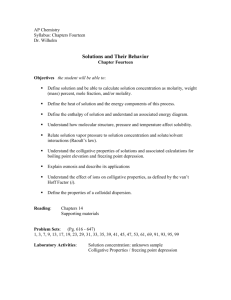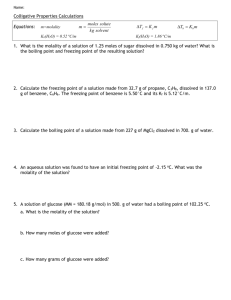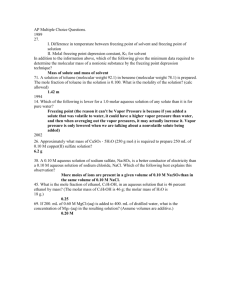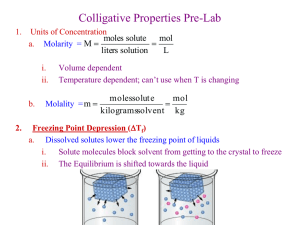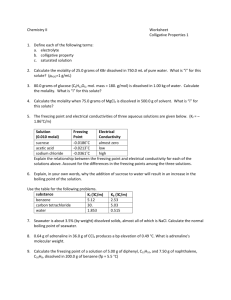Freezing Point Depression of Acetic Acid
advertisement
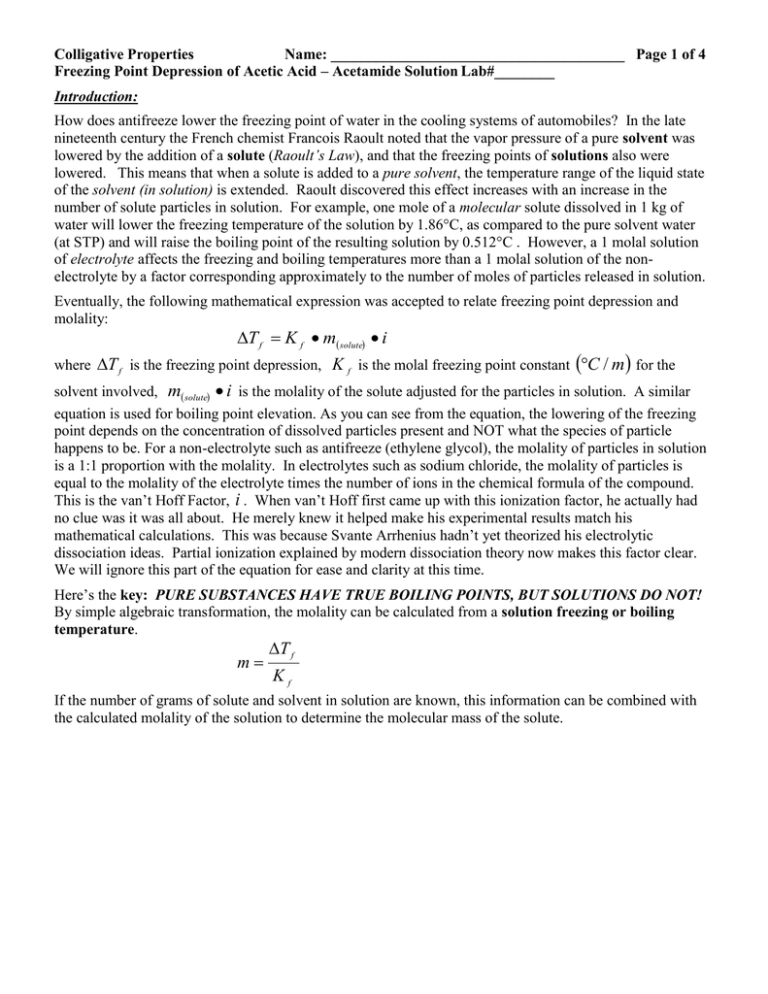
Colligative Properties Name: _______________________________________ Page 1 of 4 Freezing Point Depression of Acetic Acid – Acetamide Solution Lab#________ Introduction: How does antifreeze lower the freezing point of water in the cooling systems of automobiles? In the late nineteenth century the French chemist Francois Raoult noted that the vapor pressure of a pure solvent was lowered by the addition of a solute (Raoult’s Law), and that the freezing points of solutions also were lowered. This means that when a solute is added to a pure solvent, the temperature range of the liquid state of the solvent (in solution) is extended. Raoult discovered this effect increases with an increase in the number of solute particles in solution. For example, one mole of a molecular solute dissolved in 1 kg of water will lower the freezing temperature of the solution by 1.86°C, as compared to the pure solvent water (at STP) and will raise the boiling point of the resulting solution by 0.512°C . However, a 1 molal solution of electrolyte affects the freezing and boiling temperatures more than a 1 molal solution of the nonelectrolyte by a factor corresponding approximately to the number of moles of particles released in solution. Eventually, the following mathematical expression was accepted to relate freezing point depression and molality: T f K f m solute i where T f is the freezing point depression, K f is the molal freezing point constant C / m for the solvent involved, m solute i is the molality of the solute adjusted for the particles in solution. A similar equation is used for boiling point elevation. As you can see from the equation, the lowering of the freezing point depends on the concentration of dissolved particles present and NOT what the species of particle happens to be. For a non-electrolyte such as antifreeze (ethylene glycol), the molality of particles in solution is a 1:1 proportion with the molality. In electrolytes such as sodium chloride, the molality of particles is equal to the molality of the electrolyte times the number of ions in the chemical formula of the compound. This is the van’t Hoff Factor, i . When van’t Hoff first came up with this ionization factor, he actually had no clue was it was all about. He merely knew it helped make his experimental results match his mathematical calculations. This was because Svante Arrhenius hadn’t yet theorized his electrolytic dissociation ideas. Partial ionization explained by modern dissociation theory now makes this factor clear. We will ignore this part of the equation for ease and clarity at this time. Here’s the key: PURE SUBSTANCES HAVE TRUE BOILING POINTS, BUT SOLUTIONS DO NOT! By simple algebraic transformation, the molality can be calculated from a solution freezing or boiling temperature. m T f Kf If the number of grams of solute and solvent in solution are known, this information can be combined with the calculated molality of the solution to determine the molecular mass of the solute. Colligative Properties Procedure: Name: _______________________________________ Page 2 of 4 PUT ON YOUR APRON AND GOGGLES! 1. Weigh a clean dry 50 mL Erlenmeyer flask. 2. CAREFULLY add approximately 20 mL of glacial acetic acid to the flask. Pour this from the small beaker provided into a graduated cylinder. Wipe up any spills immediately with a water-soaked paper towel. 3. Weigh both the flask and its contents. 4. Determine the freezing point of the acetic acid in this manner: Place the flask in an ice bath (250 mL beaker about half-filled with ice and water Support the thermometer in the small flask with your finger around the flask and the thermometer, but do not use it to stir as this introduces an additional source of heat Record the temperature about every 30-45 seconds until the temperature does not change for 3 identical temperatures over about 1-1-1/2 minutes (second student should be timing the intervals and recording temps) !! you are NOT trying to make a Popsicle on the tip of the thermometer – remember that freezing temperature is reached AS SOON AS frozen crystals appear – it will continue this freezing until all solvent is frozen and that’s not what we’re after! A little slush is good 5. Allow the acetic acid to melt. You can gently warm in your hands or even run the flask carefully under a warm stream of tap water - !!! do not let the water get into the flask!! 6. Meanwhile, tare a piece of weighing paper and weigh out approximately 3 grams of acetamide CH 3 CONH 2 7. You will have to very carefully make a cone out of the weighing paper and NOT SPILLING ANY OF THE ACETAMIDE, insert this cone into the mouth of the small Erlenmeyer flask and tap the paper until ALL the solute is in the solvent. 8. Dissolve by gently swirling. If the flask is warmed from melting the acid, it will facilitate the solvation of the acetamide. 9. Using the same procedure as above (#4), determine the new freezing temperature of the solution. Record the time intervals and temperatures as above. Data: A. weight of flask (g) _______________________________ B. weight of flask + acetic acid (g) _______________________________ C. weight of acetic acid (g) (B – A) _______________________________ D. freezing point of pure acetic acid solvent(°C) _______________________________ E. weight of acetamide added (g) _______________________________ F. freezing point of acetic acid–acetamide solution _______________________________ G. freezing point depression (°C) - T f H. calculate molality _______________________________ _______________________________ Colligative Properties m T f Kf Name: _______________________________________ Page 3 of 4 where K f acetic acid 3.90C / m I. calculate the molecular mass of acetamide _______________________________ molality (H) = #moles solute / kg solvent (H) since molality = # mols (n) / kg solvent, calculate for # mols solute n molality kg solvent or (H)(C) – be sure (C) is in kg! Molar mass (MM) = g solute or (E)/ n mols solute For the % error use a normal molar mass calculation and compare this theoretical value with your experimental value from above – SHOW ALL WORK J. Calculate your % error based on molar mass from the formula in step #6 of the procedure. Show Work! ______________________________ Conclusions: complete sentences 1. Explain in sentences major sources of error in this experiment. 2. Calcium chloride is actually the salt used to melt ice on roads and sidewalks NOT sodium chloride. Explain why ice melts when the outside temperature is below the freezing point of water. Explain why the calcium chloride is a preferred treatment over sodium chloride to accomplish the task of melting snow and ice on roads and sidewalks. Colligative Properties Name: _______________________________________ Page 4 of 4 3. Arrange a 1.0 molal solution of the following solutes in order of DECREASING freezing points. Indicate your reasoning. 3 2 2 3 a) C 2 H 5 OH b) Cr2 SO4 3 c) K 2 Cr2 O7 d) Na3 PO4 4. Write a conclusion paragraph about what this lab teaches about colligative properties and any improvements/problems you had with the lab.


